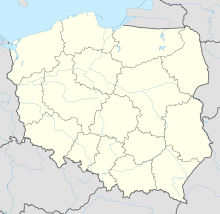Krzywy Las
Coordinates: 53 ° 12 ′ 50 ″ N , 14 ° 28 ′ 30 ″ E
The Krzywy Las ( Polish for: "crooked forest" or "slate forest") is a forest area in Poland . It is a natural monument that is now looked after by the Wełtyń Forest Community.
Geographical location
The forest is located about one and a half kilometers northeast of the village of Neu Zarnow and four kilometers south of the municipality of Greifenhagen , just under 150 m from the Unteroder power plant . It covers about 1.7 hectares .
description
The name "Krummer Wald" goes back to around 400 deformed pine trees . These trees are about 40 cm above the ground curved by 90 °, the curve is about 1–3 m , after which the trees grow straight up again. Because of this growth form, the trees are reminiscent of upside-down question marks . Due to pest infestation and other destructive events, around 100 of these conifers are currently still standing. The pines themselves are between 11 and 15 m high, the age of the forest is estimated to be around 70 to 80 years. It was planted in the late 1930s when the former province of Pomerania was still part of Germany .
Theories about the curvature of the jaws
The most widespread theory so far is that the trees were intentionally shaped in order to use them for building furniture , ships or the like , for example . Another theory says that up to the end of the 19th century, the technique of stick knocking was widespread in all of Central Europe in low forestry . A young tree that is capable of shoots is felled above the first shoot in order to obtain useful wood from the growing shoots, such as willow branches or linden and alder shoots for household appliances.
Another theory is that the young trees were rolled down by heavy tanks in World War II when Greifenhagen came under fire. The sapling recovered and the noticeable curvature arose. However, it remains unclear why crooked trees only grow here in such a small and sharply delineated area.
In 2017, German researchers offered a more recent explanation: a local forester is said to have planted the young pines and harvested their tips as Christmas trees . The side shoots should then produce new Christmas trees again, but this did not happen for unknown reasons.
After all, the effects of strong magnetic fields , a natural disaster , disease and / or toxic chemicals in the soil are still widely used as explanations. In addition, the forest is said to be haunted .
literature
- Gunnar Strunz: Uckermark: Between Schorfheide and the Lower Oder Valley National Park. 46 tours. With GPS tracks . Bergverlag Rother GmbH, Munich 2017, ISBN 3763344977 , pages 160–162.
- Kilian Schönberger, Viktoria Urmersbach: Forest worlds . Frederking & Thaler Verlag GmbH, Munich 2017, ISBN 3954162296 , pp. 309-312.
- Andrea Sarubbi Fereshteh: In the Company of Trees: Honoring Our Connection to the Sacred Power, Beauty, and Wisdom of Trees . Adams Media, New York 2019, ISBN 9781507209547 , p. 48.
Web links
- Background information on Krzywy Las on gryfino.pl (Polish); last accessed on April 14, 2018
- Piotr Cieśliński: Kto odkryje tajemnicę Krzywego Lasu . Internet article from January 15, 2014 on wyborcza.pl (Polish); last accessed on April 10, 2018


